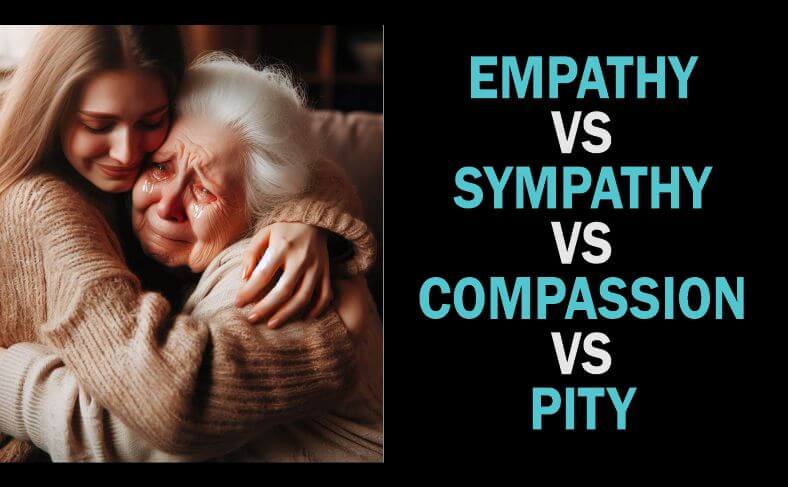Last updated on June 10th, 2025 at 01:59 pm
Empathy vs Sympathy vs Compassion vs Pity: Discover the subtle but powerful differences between these emotions and why understanding them can transform your relationships, communication, and emotional intelligence.
When someone shares their pain with you, how do you respond?
Do you feel what they feel, try to comfort them, or feel sorry from a distance?
You’ve probably heard the words empathy, sympathy, compassion, and pity used like they mean the same thing.
But they don’t. Each one has a different tone and impact.
These emotions play important roles in building trust and creating a sense of connection and belonging through interpersonal insight.
Understanding these differences helps you connect better with others and respond in ways that actually help.
In this guide, we break down empathy vs sympathy vs compassion vs pity in clear terms you can relate to.
You’ll see how these emotions show up in daily life and how your response shapes your relationships.
Ready to understand how you connect with people and what your reactions mean? Let’s get into it.
Related: The Power of Emotions: Types and Their Influences
Table of Contents
- What is Empathy?
- What is Sympathy?
- What is Compassion?
- What is Pity?
- Comparison Table
- Frequently Asked Questions
- Final Word from The Conducts of Life
What is Empathy?
Empathy means you truly feel what another person is going through.
It’s about stepping into their shoes and understanding their emotions from their point of view.
When a friend shares a struggle, you don’t just hear their words, you sense their pain or joy deeply.
Empathy helps in conversations, healing, and building trust.
It’s most helpful during tough times like grief or stress because it connects you with others on a heartfelt level, making your support feel genuine and personal.
What is Sympathy?
Sympathy means you recognize someone’s pain, but you don’t feel it yourself.
You acknowledge their struggle and show care without fully entering their emotional space.
For example, when a coworker loses a pet, you offer condolences without sharing their sadness.
Sympathy can comfort by letting others know you see their pain, but it might also create distance if it feels distant or polite rather than personal.
It’s a way to express concern without deep emotional involvement.
Related: What Is Self-awareness? Development, Types, And Examples
What is Compassion?
Compassion means feeling concern and wanting to help someone in need. It goes beyond just feeling sorry, it pushes you to act.
Whether you help a friend during illness or support a stranger in crisis, compassion turns kindness into real support.
In relationships, compassion builds trust because it shows you care enough to step in and assist.
This active kindness strengthens bonds and makes others feel truly cared for when they face challenges or need comfort.
What is Pity?
Pity means you feel sorry for someone’s situation, but keep an emotional distance.
It’s a sense of sadness for their hardship without truly understanding or connecting with their feelings.
For example, when someone struggles and you respond with pity, it can seem like you’re looking down on them rather than supporting them.
Pity can feel condescending and create a barrier, making the person feel weaker or judged instead of comforted or understood.
It often does more harm than good.
Related: What Is Emotional Hijacking?
Comparison Table
Understanding the differences between empathy, sympathy, compassion, and pity helps you respond better to others’ feelings.
Each involves different emotional depth, involvement, and reactions.
Knowing these can improve your relationships and communication by matching your response to what someone truly needs.
Emotional Depth
Empathy connects you deeply to another person’s feelings, letting you experience their emotions as if they were your own.
Sympathy recognizes pain but keeps you outside that emotional space.
Compassion adds caring action to feeling concern, while pity stays distant, feeling sorry without understanding or sharing the emotions involved.
Level of Involvement
With empathy, you immerse yourself emotionally, fully engaging with someone’s experience.
Sympathy keeps you more detached, offering acknowledgment without emotional participation.
Compassion drives you to help actively, moving beyond feelings.
Pity maintains emotional distance, often feeling like judgment rather than support, creating separation instead of connection.
Common Responses
Empathy often leads you to listen closely and offer meaningful comfort.
Sympathy results in polite expressions like “I’m sorry.” Compassion encourages acts of kindness or assistance.
Pity tends to come across as pitying looks or words that may feel patronizing or dismissive, leaving the person feeling misunderstood or belittled.
Related: How to Develop Emotional Intelligence in Different Areas of Life
Social Impact
Empathy builds trust and closeness in relationships by initiating true understanding.
Sympathy provides basic social support but can feel formal or distant.
Compassion strengthens bonds through helpful actions that meet needs.
Pity risks damaging relationships by making others feel inferior or isolated rather than supported or valued.
How to Respond Mindfully in Real Situations
Responding mindfully means tuning in to what someone truly needs from you.
Your choice to show empathy, compassion, or hold back pity shapes how your support feels.
Being aware of emotions helps you respond in ways that build connection and respect in any situation.
Tips to Recognize What Someone Needs
Pay attention to words and feelings beneath the surface. Notice if they want to be heard, helped, or just comforted.
Ask gentle questions and watch body language.
This helps you avoid assumptions and respond in a way that meets their true emotional needs instead of your expectations.
When to Lean Into Empathy, Express Compassion, or Step Back from Pity
Use empathy to share feelings when someone needs understanding. Show compassion when action or support is needed.
Avoid pity, it can create distance and hurt.
Stepping back means respecting their strength and autonomy, giving space instead of sympathy that feels like judgment or weakness.
Emotional Awareness in Conversations and Relationships
Stay mindful of your feelings and reactions during talks. Recognize when emotions rise and how they affect your response.
This awareness helps you stay present, listen better, and avoid knee-jerk replies.
Building emotional awareness strengthens trust and keeps relationships balanced and healthy.
Frequently Asked Questions
What is the difference between empathy pity sympathy and compassion?
Empathy is understanding and sharing the feelings of others. Pity is feeling sorry for someone’s suffering. Sympathy shows support or concern. Compassion combines empathy and a desire to help.
Is pity considered empathy?
Pity can involve feeling sorry for someone, but it may not always mean the deeper understanding of their emotions and experiences that empathy includes.
What kind of emotion is pity?
Pity is a complex emotion that involves feeling sorry for someone who is suffering or facing challenges, often accompanied by a desire to help or the opposite.
What is the difference between feeling sorry and pity?
Feeling sorry is a general response to a situation, while pity involves a more focused feeling of sorrow directed towards someone who is experiencing hardship or difficulty.
Final Word from The Conducts of Life
In conclusion, cultivating empathy, sympathy, and compassion involves conscious efforts in active listening, self-reflection, mindfulness, and community involvement.
By adopting these practices, we can create a more empathetic world and avoid the isolating tendencies of pity.
We have examined and clarified the distinction between empathy vs sympathy vs compassion, vs pity.
These are qualities to build relationships that stand the test of time. They encourage understanding, creating a more caring and empathetic society.
References:
- https://www.linkedin.com/pulse/understanding-compassion-empathy-sympathy-pity-karla-campbell
- https://riseservicesinc.org/news/sympathy-empathy-compassion-pity/
- https://www.quora.com/What-is-the-difference-between-pity-sympathy-empathy-and-compassion-in-terms-of-people-reacting-to-anothers-situation-What-situation-s-are-any-of-the-reactions-most-appropriate
Pious Clements is the insightful voice behind "The Conducts of Life" blog, where he writes about life ethics, self-development, life mastery, and the dynamics of people and society.
With a profound understanding of human behaviuor and societal dynamics, Pious offers thought-provoking perspectives on ethical living and personal growth.
Through engaging narratives and astute observations, he inspires readers to navigate life's complexities with wisdom and integrity, encouraging a deeper understanding of the human experience and our place within society.

